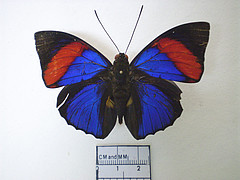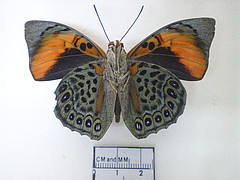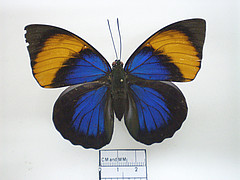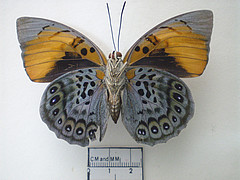Agrias narcissus (Staudinger,[1885])
Narcissus Agrias
In the Neotropics, are registered 3 subspecies (Lamas, 2004).
Are butterflies of robust body and flight fast. Males and females can be recorded throughout the year in understory strata and forest canopy. Are butterflies flying fast and robust body.
Brasil; Guyane française; Suriname; Venezuela
This species occurs throughout the year
Adults feed on fermented fruits, vegetables exudates, animal excrement
In the Neotropics host-plants of Charaxinae are included in Euphorbiacea, Fabaceae, Mimosaceae, Lauraceae, Annonaceae, Piperaceae, Erythroxylaceae, Convolvulaceae, Monimiaceae and Quiinaceae (Canseco, 2007).
blue, red, yellow, orange, black
forest
- Lamas G. (2004):
- Atlas of neotropical Lepidoptera - Checklist: Part 4A Hesperioidea - Papilionoidea. Book.: 1-439
- Canseco A.J.M.D. (2007):
- Mariposas - Guía para el manejo sustentable de las mariposas del Perú. Book., Instituto de Investigaciones de la Amazonía Peruana: 1-99
-

Male, from dorsal
Specimen deposited in the Collection of Invertebrates INPA, Manaus, Amazonas
-

Male, from ventral
Specimen deposited in the Collection of Invertebrates INPA, Manaus, Amazonas
-

Female, from dorsal
Specimen deposited in the Collection of Invertebrates INPA, Manaus, Amazonas
-

Female, from ventral
Specimen deposited in the Collection of Invertebrates INPA, Manaus, Amazonas



